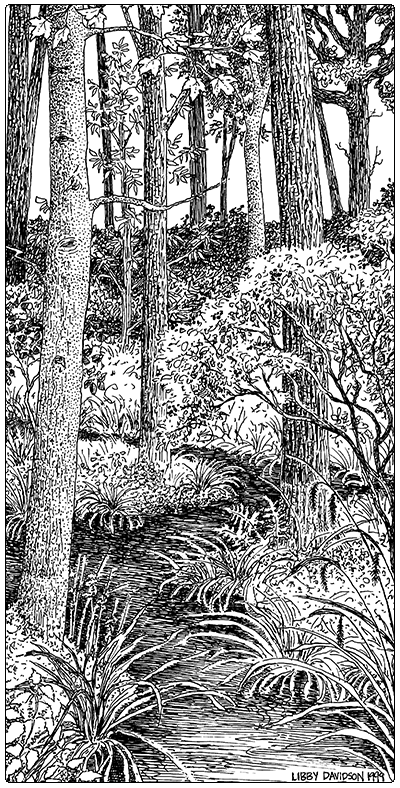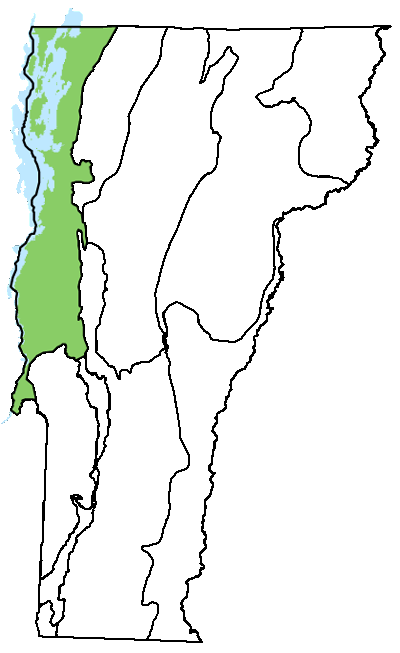Ecology and Physical Setting 
The rattling chorus of leopard frogs, tufts of fringed sedge arching above flooded hollows, and water-stained, buttressed tree trunks let you know you’re in a Maple-Green Ash Swamp. Most of these swamps are found in the Champlain Valley, where they mostly occur adjacent to Lake Champlain. They also occur in isolated depressions and in the floodplains of rivers like Otter Creek. The common hydrologic characteristics are extended spring flooding, and saturated soils during the remainder of the growing season. The soils of Maple-Green Ash Swamps are typically deep, well-decomposed organic deposits, but shallow organic and mineral soils are present in some areas. The ground surface in most of these swamps has distinct hummocks and water-filled hollows.
Maple-Green Ash Swamps adjacent to Lake Champlain are typically located in former bays of the lake that are filled with organic soil deposits and are now separated from the lake by sand or shale berms. In these settings, deepwater marshes commonly occur lakeward of the forested swamp and may include scattered young trees. These pioneering young trees, as well as the larger, well-established trees on the lakeward side of the swamp may be killed by especially long duration spring or early summer flooding. It is common to see dead trees at the lower, lakeward limits of these swamps. Rising lake levels over the past century may partly explain this. Lakeside Floodplain Forests are commonly present on the slightly higher elevations and mineral soils landward of the swamps.
Along Otter Creek, Maple-Green Ash Swamps occur on deep organic soils that are within the active floodplain of the river. These swamps are adjacent to riverine floodplain forests, which occur on the alluvial soils of the river levees. Farther away from the river and at elevations that are flooded for shorter periods, the Maple-Green Ash Swamps may grade into Red Maple-Black Ash Seepage Swamps or Red Maple-Northern White Cedar Swamps. Maple-Green Ash Swamps also occur in isolated depressions underlain with fine-textured mineral soils that drain slowly. In such basins, spring runoff accumulates and standing water may be present for significant periods of the spring. This creates a flooding regime similar to that found in swamps adjacent to Lake Champlain or Otter Creek. These basins may have organic or mineral soils, depending on the duration of soil saturation.
Vegetation
The forest structure of Maple-Green Ash Swamps can resemble that of floodplain forests, especially when silver maple is the dominant tree and forms a high canopy of spreading crowns. In other cases, the canopy may be dominated by red maple and/or Freeman’s maple, a hybrid between the two soft maples. Green ash is an important component of the canopy in all sites and may dominate in some. Other trees include cottonwood, swamp white oak, yellow birch (on hummocks), slippery elm, American elm, and occasionally black ash.
 The shrub layer is typically well developed. Along with seedlings and saplings of the overstory tree species, shrubs include winterberry holly, American black currant, silky dogwood, red-osier dogwood, poison sumac, highbush blueberry, and nannyberry. The herb layer is diverse and varies with the amount of microtopographic relief. The most common herbs are sensitive fern, fringed sedge, Tuckerman’s sedge, and hop sedge. Bryophytes are abundant and may form nearly continuous cover on hummocks, with sphagnum moss especially abundant.
The shrub layer is typically well developed. Along with seedlings and saplings of the overstory tree species, shrubs include winterberry holly, American black currant, silky dogwood, red-osier dogwood, poison sumac, highbush blueberry, and nannyberry. The herb layer is diverse and varies with the amount of microtopographic relief. The most common herbs are sensitive fern, fringed sedge, Tuckerman’s sedge, and hop sedge. Bryophytes are abundant and may form nearly continuous cover on hummocks, with sphagnum moss especially abundant.
Wildlife Habitat
Situated adjacent to Lake Champlain or in floodplains of larger rivers, Maple-Green Ash Swamps are near the permanent water needed for overwintering by northern leopard frogs and green frogs. Both frogs forage in these swamps, especially in the deeper pools. Leopard frogs breed in the standing water of deep pools. The rare blue-spotted salamander and four-toed salamander are found in the moist and mossy portions of these swamps, in areas with less flooding.
Mature swamps with large trees near the lake or a river are important for the cavity-nesting wood duck, hooded merganser, common merganser, and common goldeneye. Despite their name, common goldeneyes are rare breeders in Vermont. They are sensitive to human disturbance and their greatest breeding success has been in swamps and floodplains along the northern portion of Lake Champlain. Black-crowned night herons are rare colonial breeders in Vermont, nesting most often on Lake Champlain islands where there are no mammalian predators. These beautiful herons roost in trees and swamps near water and may be seen hunting for small fish, frogs, or other small aquatic animals in shallow waters. Other breeding birds of these swamps include northern waterthrush, yellow warbler, great crested flycatcher, and the rare blue-gray gnatcatcher and red-shouldered hawk.
Related Communities
- Red Maple-Black Ash Seepage Swamp is dominated by red maple and black ash, and typically lacks the silver maple and green ash found in Maple-Green Ash Swamps. Herbs and shrubs indicate groundwater seepage, the primary source of water in these swamps. There is little or no spring flooding.
- Lakeside Floodplain Forest typically occurs at a slightly higher elevation, sometimes within the same former lake cove. Lakeside Floodplain Forests have mineral soils that are not saturated throughout the growing season.
Conservation Status and Management Considerations
Most known examples of this rare community type are associated with Lake Champlain and Otter Creek. The flooding regimes of these water bodies shape the species composition and ecological characteristics of the swamps. In order to maintain these flooding regimes, the naturally-forming beach berms and river levees should be maintained or restored.
Several Maple-Green Ash Swamps are protected on conserved lands.
Distribution/ Abundance 
Maple-Green Ash Swamps are known from the Champlain Valley, with similar communities described from New York. Closely related communities occur in southern New England.
Characteristic Plants
Trees
Abundant Species
Red maple – Acer rubrum
Silver maple – Acer saccharinum
Green ash – Fraxinus pennsylvanica
Freeman’s maple – Acer ×freemanii
Occasional to Locally Abundant Species
Cottonwood – Populus deltoides
Yellow birch – Betula alleghaniensis
Slippery elm – Ulmus rubra
American elm – Ulmus americana
Swamp white oak – Quercus bicolor
Black ash – Fraxinus nigra
Bur Oak – Quercus macrocarpa
Shrubs and Vines
Abundant Species
Winterberry holly – Ilex verticillata
Occasional to Locally Abundant Species
American black currant – Ribes americanum
Silky dogwood – Cornus amomum
Red-osier dogwood – Cornus sericea
Poison sumac – Toxicodendron vernix
Highbush blueberry – Vaccinium corymbosum
Nannyberry – Viburnum lentago
Riverbank grape – Vitis riparia
Black elderberry – Sambucus nigra
Canada yew – Taxus canadensis
Herbs
Abundant Species
Sensitive fern – Onoclea sensibilis
Fringed sedge – Carex crinita
Occasional to Locally Abundant Species
Spotted touch-me-not – Impatiens capensis
Retrorse sedge – Carex retrorsa
Hop sedge – Carex lupulina
Tuckerman’s sedge – Carex tuckermanii
False nettle – Boehmeria cylindrica
Tall meadow rue – Thalictrum pubescens
Marsh fern – Thelypteris palustris
Cinnamon fern – Osmundastrum cinnamomeum
Bluejoint grass – Calamagrostis canadensis
Tufted loosestrife – Lysimachia thyrsiflora
Common beggar’s-ticks – Bidens frondosa
Nodding bur marigold – Bidens cernua
American water horehound – Lycopus americanus
Northern bugleweed – Lycopus uniflorus
Stout woodreed – Cinna arundinacea
Drooping bulrush – Scirpus pendulus
Rare and Uncommon Plants
Yellow water-crowfoot – Ranunculus flabellaris
Nodding trillium – Trillium cernuum
Gray’s sedge – Carex grayi
False hop sedge – Carex lupuliformis
Cyperus-like sedge – Carex pseudocyperus
Loesel’s twayblade – Liparis loeselii
Foxtail sedge – Carex alopecoidea
Cattail sedge – Carex typhina
Associated Animals
Gray treefrog – Hyla versicolor
Northern leopard frog – Lithobates pipiens
Green frog – Lithobates clamitans
Northern waterthrush – Parkesia noveboracensis
Yellow warbler – Setophaga petechia
Great crested flycatcher – Myiarchus crinitus
Veery – Catharus fuscescens
Red-eyed vireo – Vireo olivaceus
Wood duck – Aix sponsa
Hooded merganser – Lophodytes cucullatus
Common merganser – Mergus merganser
Mallard – Anas platyrhynchos
Rare and Uncommon Animals
Blue-spotted salamander – Ambystoma laterale
Four-toed salamander – Hemidactylium scutatum
Indiana bat – Myotis sodalis
Red-shouldered hawk – Buteo lineatus
Blue-gray gnatcatcher – Polioptila caerulea
Black-crowned night-heron – Nycticorax nycticorax
Common goldeneye – Bucephala clangula
Appalachian brown – Lethe appalachia
Places to Visit
Mud Creek Wildlife Management Area, Alburgh, Vermont Fish and Wildlife Department (VFWD)
Alburgh Dunes State Park, Alburgh, Vermont Department of Forests, Parks, and Recreation (VDFPR)
North Hero State Park, North Hero, VDFPR
Halfmoon Cove Wildlife Management Area, Colchester, VFWD
Cornwall Swamp, Cornwall and Whiting, VFWD and The Nature Conservancy
Rossetti Beach Natural Area, Colchester, Lake Champlain Land Trust
